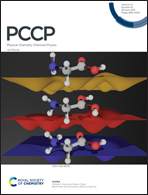A significant enhancement of sodium ion conductivity in phosphate glasses by addition of WO3 and MoO3: the effect of mixed conventional–conditional glass-forming oxides
Abstract
Ion conducting oxide glasses are attractive materials for application in various electrochemical devices and an understanding of the structure–transport properties relationship is crucial for their development. An interesting effect of glass structure on the dynamics of mobile ions is the mixed glass-former effect which causes a non-linear change of ionic conductivity when glass-forming oxides get gradually substituted. Here, we report a strong, positive effect of structural changes on the conductivity of sodium ions in two glass systems 40Na2O–xMoO3–(60−x)P2O5 and 40Na2O–xWO3–(60−x)P2O5; x = 0–50 mol% where a conventional glass-forming oxide (P2O5) is gradually replaced by WO3/MoO3 which are conditional ones. In both glass systems, the compositional change in DC conductivity is non-linear, with the maximal increase of four orders of magnitude in the case of WO3 and three orders of magnitude in the case of MoO3. This significant enhancement of ionic conductivity is related to the formation of mixed phosphate–tungstate and phosphate–molybdate units in the glass network. The facilitating effect of these structural units on sodium ion dynamics is also observed in the changes of the shape of frequency-dependent conductivity and in the values of typical spatial extent of diffusion of sodium ions known as the Sidebottom length.

- This article is part of the themed collection: 2021 PCCP HOT Articles


 Please wait while we load your content...
Please wait while we load your content...